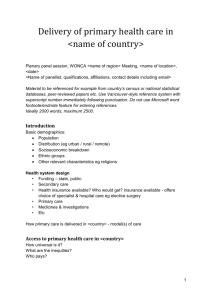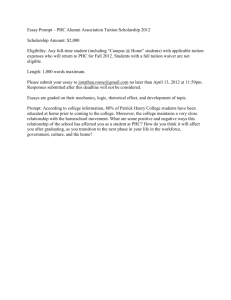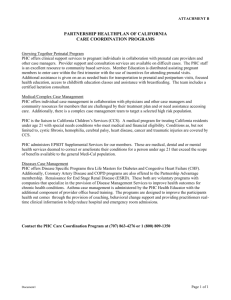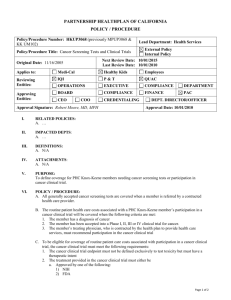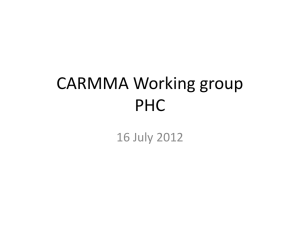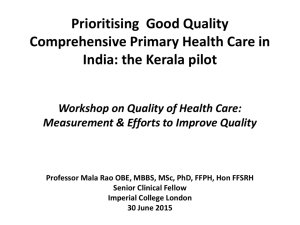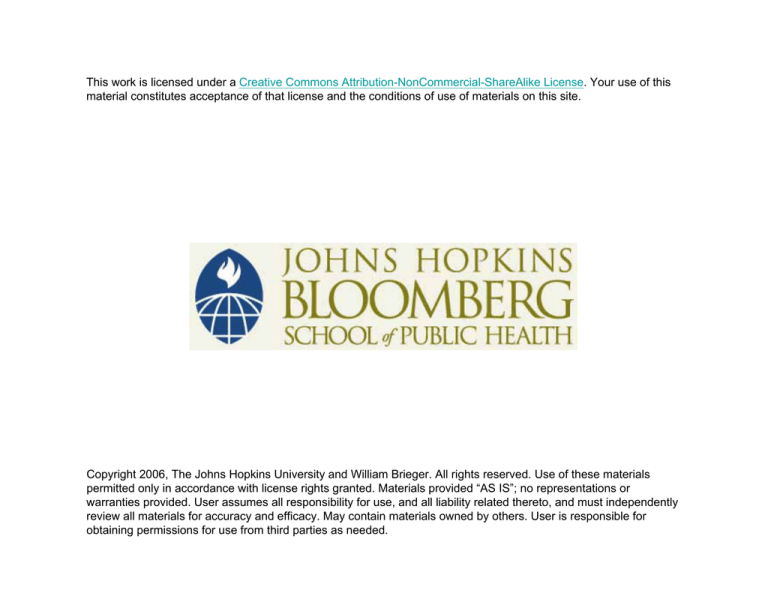
This work is licensed under a Creative Commons Attribution-NonCommercial-ShareAlike License. Your use of this
material constitutes acceptance of that license and the conditions of use of materials on this site.
Copyright 2006, The Johns Hopkins University and William Brieger. All rights reserved. Use of these materials
permitted only in accordance with license rights granted. Materials provided “AS IS”; no representations or
warranties provided. User assumes all responsibility for use, and all liability related thereto, and must independently
review all materials for accuracy and efficacy. May contain materials owned by others. User is responsible for
obtaining permissions for use from third parties as needed.
Introduction to
Primary Health Care
William R. Brieger, MPH, CHES, DrPh
Johns Hopkins University
1
Section A
What Is Primary Health Care?
2
PHC Is Essential Health Care
Ù Practical, scientifically sound, and
socially acceptable methods and
technology
Ù Made universally accessible to
individuals and families in the
community
Continued 3
PHC Is Essential Health Care
Ù Through their full participation
Ù At a cost that the community and
country can afford to maintain at every
stage of their development
Ù In the spirit of self-reliance and selfdetermination
4
Primary Health Care
Ù Forms an integral part of the country’s
health system
Ù Is the central function and main focus
Ù Is also integral to the overall social and
economic development of the
community
Continued 5
Primary Health Care
Ù Is the first level of contact for
individuals, the family, and the
community with the national health
system
Ù Is a continuing health care process
Ù Brings health care as close as possible
to where people live and work
6
Primary Health Care
In a Social Context
Ù Reflects and evolves from the
economic conditions and socio-cultural
and political characteristics of the
country and its communities
Ù Is based on the application of the
relevant results of social, biomedical
and health services research, and
public health experience
Continued 7
Primary Health Care
In a Social Context
Ù Addresses the main health problems in
the community, providing promotive,
preventive, curative, and rehabilitative
services accordingly
8
Essential Components/Services
that Comprise PHC
Ù At the time of Alma Ata, eight services
were defined
Ù Since then more have been added by
– International agencies
– Individual countries
9
Eight Essential Components
of PHC Services
1. Education concerning
prevailing health problems
and methods of preventing
and controlling them
(planned learning activities,
voluntary behavior change,
full participation)
Source: Save the Children
Continued 10
2. Promotion of food supply and proper nutrition
Continued 11
3. Maternal and child health care,
including family planning
Continued 12
4. Immunization
against the major
infectious diseases
Polio may soon be
eradicated through
worldwide
immunization
campaigns
Continued 13
Source: The Carter Center
5. Prevention and control of locally endemic
diseases such as Guinea Worm and malaria
Continued 14
Images courtesy of the Carter Center
6. Supply of adequate water and sanitation: Drink
water from a sanitary well (left)—not a guineaworm infested pond (right)
Note: Man on right
is using a filtering pipe to drink out of pond.
Continued 15
7. Appropriate treatment of
common diseases and
injuries at a local
government health center;
from a village health worker
Continued 16
8. Provision of essential
drugs: essential drug lists,
Bamako Initiatives—revolving
funds; collaboration with
indigenous healers; training
patent medicine vendors
17
PHC Involves
Ù All related sectors and aspects of national
and community development
Ù Maximum community self-reliance and
participation in the planning, organization,
operation, and control of care
Ù Making fullest use of local, national, and
other available resources
Ù Developing (through appropriate
education) the ability of communities to
participate
18
PHC Relies on
Ù Integrated, functional, and mutually
supportive referral systems
Ù Health workers, including physicians,
nurses, midwives, auxiliaries,
community workers, and traditional
practitioners
Ù A response to the expressed needs of
the community
Ù The spirit of partnership and service
19
PHC Aims to Achieve
Ù An acceptable level of health for all the
people of the world
Ù A fuller and better use of world’s
resources, through a genuine policy of
independence, peace, détente, and
disarmament
Ù An acceleration of social and
economic development, of which PHC
is an essential part
20
Section B
Social Sciences
21
Social Sciences
Ù Sociology is the general science of
society and is concerned with
relationships
– The family
– Social groups
– Roles and responsibilities
– Social networks
Continued 22
Unity Star Club
23
Social Sciences
Ù Economics studies how individuals
and societies use productive resources
available to them
Cost may be
one reason why
these maternity
beds are empty
Continued 24
Social Sciences
Ù Anthropology is the study of the culture
and way of life of various societies
The crocodile, symbol of the
river goddessYemoja,helps
prevent smallpox brought on
by the wrath of the Supreme
Being, Olodumare,
represented by Soponna
Continued 25
Social Sciences
Ù Political science looks at the use of
power, the machinery of government,
the formulation and implementation of
policy, and the decision-making process
– May start with airing views at a
village meeting
– Challenge in public health of greeting
grassroots views heard by policy
makers
Continued 26
Village meeting
27
Social Sciences
Ù Geography concerns the distribution of
human activities in space
– Onchocerciasis if live near river
– Delay in care if live far from facility
– Poor road network, higher cost of
products
Continued 28
Map of Ido
29
Implications of the Social Sciences
For the Contents of Alma Ata
Ù
Ù
Ù
Ù
Ù
Sociological
Geographical
Political
Economical
Cultural/Anthropological
30
Sociological Implications
Ù Permit them to lead a socially
productive life
Ù Evolves from the socio-cultural
characteristics of the country
Ù Involves all related sectors and aspects
of national and community development
Ù Contact of individuals, the family, and
the community with the national health
system
31
Geographical Implications
Ù Made universally accessible
Ù Bringing health care as close as
possible to where people live and work
Ù Local and referral levels
32
Political Implications
Ù
Ù
Ù
Ù
Existing gross inequality is unacceptable
Through their full participation
In the spirit of social justice
Governments have a responsibility for
the health of their people
Ù In the spirit of self-determination
Ù Giving priority to those in most need
Ù All governments should formulate
national policies
33
Economic Implications
Ù Permit them to lead an economically
productive life
Ù Spirit of self-reliance
Ù At a cost that the community and
country can afford to maintain
Ù Reflects the economic conditions
Ù Making fullest use of local, national,
and other available resources
34
Cultural Implications
Ù Socially acceptable methods and
technology, as well as traditional
practitioners
Ù Expressed needs of the community
35
Section C
Approaches to PHC
36
Two Approaches to PHC
Comprehensive PHC According to Alma Ata
Ù Second order change
– A new way of doing things
Ù Community development
Ù Full participation
Ù Community diagnosis
Ù Change in relationships/partnership
Ù Organizational change
37
Rethinking PHC
Selective Primary Care
Ù First order change
– Substitution of one way for another
Ù Target diseases
Ù Specific technologies
Ù Focused ethnographic assessment
Ù Individual behavior change
Ù Organizational enhancement
38
Comprehensive PHC
Focuses on Processes
Ù Health development: Local leadership
and capabilities
Ù How interventions might be accepted
in context of local cultural practices,
organizational strengths, and
appropriate technologies
39
Selective PHC
Focuses on Programs and Products
Ù For example, oral rehydration,
immunization, and bed nets
Ù Identifying and transferring specific,
effective, and economical technologies
designed to reduce disease morbidity
and morality
40
Different Approaches to PHC
Ù Imply different understandings of the
role of human behavior in health
– Selective PHC
• Behavior as an item to be
targeted with messages and
manipulated for health effects
Continued 41
Different Approaches to PHC
– Comprehensive PHC
• Behavior as an integrated part of
personality and culture
• The person and community have
the right to change or not
• Behavior change arises through
dialogue and mutual
understanding
Copyright 2005, The Johns Hopkins University and Bill Brieger. All rights reserved. Use of these materials permitted only in accordance with license rights granted.
Materials provided “AS IS”; no representations or warranties provided. User assumes all responsibility for use, and all liability related thereto, and must
independently review all materials for accuracy and efficacy. May contain materials owned by others. User is responsible for obtaining permissions for use from
third parties as needed.
42

